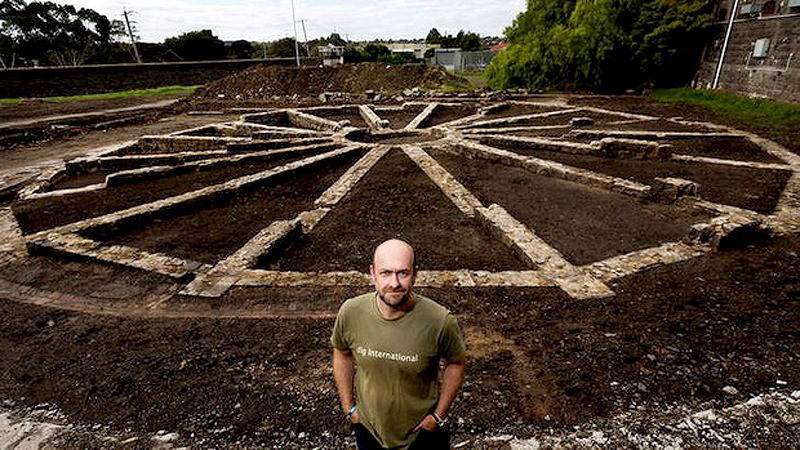Archaeologists say remains of a rare, circular 1850s prison block unearthed at the former Pentridge Prison is of world significance in penal history.
The public will next month be able to view the extraordinary bluestone foundations of the panopticon, shaped like a Trivial Pursuit token, which experts say is one of the few examples of its type to survive.
It was part of a brutal 19th-century movement to keep prisoners in solitary contemplation, under total surveillance.
Pentridge had three: this one, next to A Division on the north of the site is the first to be unearthed. Later in May, excavation will start on two more next to B Division to the south.
Archaeologist and ABC TV host Adam Ford said a teenage Ned Kelly, when at Pentridge for three years in the early 1870s, would have spent time in at least one of them. ‘‘He went in to Pentridge a 16-year-old as a ratbag and came out as a hardened criminal with a big chip on his shoulder.’’
In A Division, new prisoners spent 23 hours alone in their tiny cells, and for the remaining hour were each marched, with caps over their eyes, into the adjacent, one-man, wedge shaped panopticon ‘‘airing yard’’.
Guards watching from a central tower knew prisoners by number. The yard had no roof, and inmates were expected to stay silent and study the Bible.
The method was ditched by the early 1900s as prisoner numbers and therefore cell sharing increased.
After its demolition in the 1950s, the ruins were buried under a yard by the time Pentridge closed in 1997.
The Taiwanese based company Shayher Group, which owns 6.76 hectares of the former prison, has employed Mr Ford’s consultancy Dig International to excavate five areas of archaeological importance as a Heritage Victoria condition of a massive housing and commercial development.
Using an excavator and then mattocks and pickaxes, the archaeologists took 10 days to expose the panopticon footings.
Mr Ford said the results exceeded all expectations. ‘‘We’ve all been completely blown away by it.’’
‘‘It’s ‘wow’ archaeology, because it gets that response – when people come around that corner they see it and it’s very striking.
‘‘We’d done some test excavations; we know stuff was here, but had no idea of its integrity and the extent and also the grandeur of the remains.
‘‘So it really wasn’t until we stood back, panting a bit after we’d finshed excavating, that we looked at it and went, ‘good grief, this is amazing’.’’
Mr Ford believes it is ‘‘the most intact foundation of this panopticon-style building anywhere in the world’’.
‘‘It will be a long time, if ever, that I get to excavate anything as special as this site.’’
He said about six prisons around the world adopted this circular style from a late 1700s idea by prison reformer Jeremy Bentham, and fewer than 12 of them were built, including at Pentonville in Britain, in Port Arthur in Tasmania, and the Old Melbourne Gaol, but little remained of most of them.
Heritage Victoria senior archaeologist Jeremy Smith, who has worked on many Victorian digs including the discovery of the remains of 35 executed inmates, including Ned Kelly at Pentridge in 2009, said the Pentridge panopticons ‘‘are rare on a world scale’’. ‘‘They give us a worldwide perspective of a different approach to the management of prisoners, particularly the deprivation of identity.’’
The dig team, which includes students from Melbourne and La Trobe universities, is now unearthing the foundations of 360 tiny cells that were part of nearby C Division.
The two-storey, 1859 bluestone C Division was condemned in the 1880s as unfit for habitation, but continued operations until its demolition in the early 1970s.
Shayher spokesman Robert Larocca, said the future of the panopticon and other finds was yet to be determined.
Dig updates will be posted from Friday, May 9 at historicpentridge.com.au. Later this month the website will post details of free public tours of the site to be held in late June.







